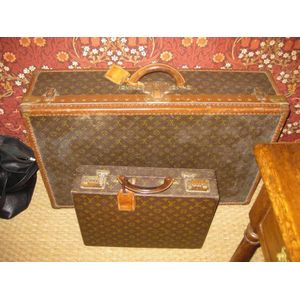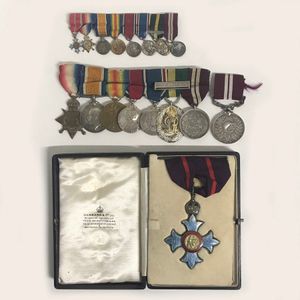Georgian Mahogany Knife Box with Harlequin Cutlery Set
You must be a subscriber, and be logged in to view price and dealer details.
Subscribe Now to view actual auction price for this item
When you subscribe, you have the option of setting the currency in which to display prices to $Au, $US, $NZ or Stg.
- Boxwood - Boxwood is a hard, yellow coloured, close grained timber. In the 19th century it was often used for inlays, especially stringing, because of its contrasting colour to the darker timbers of the carcase. Stringing is the inlay of a narrow strip of veneer of a lighter colour, such as boxwood along or close to the edges of an object that has been veneered in a darker timber such as mahogany.
Because of its fine grain and resistnce to splitting or chipping it has also been used for treen, turnings, carvings and other small wooden items, such as chess pieces. - Chevron Motif - In jewellery, a chevron is a V-shaped pattern or design that is often used to create a bold and striking visual effect, and as a symbol of strength, power and protection.. It is a classic motif used in many different styles of jewellery and can be seen in various forms such as on a ring, earrings, bracelets, and necklaces. It can be created with precious or semi-precious stones, pearls, or enamel. It can be found in different forms such as engraved or inlaid or beaded.
In ceramics the pattern is often used in decorative pottery and porcelain pieces, such as vases, bowls, plates and figurines. The chevron pattern can be created by using different colored glazes or by hand-painting the design onto the piece. It is also commonly found in the form of embossing or intaglio in decorative ceramic objects. This pattern can be seen as a popular design choice in Art Deco and Art Nouveau style of ceramics.
This chevron pattern can also be found in many different types of furniture, such as tables, chairs, chests of drawers, and cabinets. A common place to find chevron pattern is in a herringbone pattern, which is made up of repeating V-shaped patterns. The chevron pattern can be created by using different types of wood, inlaying or by using different colors of stain. It is also commonly found in the form of a veneer. This pattern can be seen as a popular design choice in mid-century modern, Art Deco, and contemporary style furniture. - Georgian - As an English stylistic period, Georgian is usually taken to cover the period from George I (1714) to the Regency of Prince George (1811-20), although the period from 1800 to 1830 is sometimes designated as the Regency period. During the Georgian period the great English cabinetmakers and designers such as Chippendale, Hepplewhite, Adam Sheraton etc., were all active.
Therefore there isn't a single 'Georgian style' as such and to say something is 'Georgian', usually means it was made between 1714 and 1830. This assumes we discount George V and George VI, both being from the 20th century.
The styles popular at the time of each reign were:
George I (1714-1727) saw out the last years of the Baroque period.
George II (1727-1760) reigned during the Rococo period.
George III (1760-1820) saw the last gasp of the Rococo, all of the early Neo-Classic 'Adam style' and most of the later neo-Classic 'Regency style'.
George IV (Prince Regent 1820-1830)encompassed the last of the 'Regency' style.
William IV's reign (1830-1837) was something of a no man's land (stylistically) and he wasn't a 'George' anyway. He covered the last glimmerings of 'Regency' and the start of the 'Victorian' style. - Ivory - Ivory is a hard white material that comes from the tusks of elephants, mammoth, walrus and boar, or from the teeth of hippopotamus and whales. The ivory from the African elephant is the most prized source of ivory. Although the mammoth is extinct, tusks are still being unearthed in Russia and offered for sale.
Ivory has been used since the earliest times as a material for sculpture of small items, both in Europe and the east, principally China and Japan.
In Asia ivory has been carved for netsuke, seals, okimono, card cases, fan supports, animals and other figures and even as carved tusks.
In the last 200 years in Europe ivory has been used to carve figures, for elaborate tankards, snuff boxes, cane handles, embroidery and sewing accessories, in jewellery and as inlay on furniture. Its more practical uses include being used for billiard balls, buttons, and a veneers on the top of piano keys.
The use and trade of elephant ivory have become controversial because they have contributed to Due to the decline in elephant populations because of the trade in ivory, the Asian elephant was placed on Appendix One of the Convention on International Trade in Endangered Species (CITES), in 1975, and in January 1990, the African elephant was similarly listed. Under Appendix One, international trade in Asian or African elephant ivory between member countries is forbidden. Unlike trade in elephant tusks, trade in mammoth tusks is legal.
Since the invention of plastics, there have been many attempts to create an artificial ivory - Harlequin Set - A harlequin set is a collection of items that are similar in style or design but feature different variations in colour, construction or pattern. The term "harlequin" comes from the traditional costume worn by a character in Italian commedia dell'arte, which is made up of different coloured patches.
For example with furniture, a harlequin set may refer to a group of chairs, typically dining chairs, where a number of the chairs are identical in design but one or more of the chairs may have a difference in the design of the leg or back. Harlequin sets can be found in silver flatware, porcelain dinner settings and glassware settings. - Mahogany - Mahogany is a dense, close grained red-coloured timber from the West Indies and Central America. It was first imported into Europe in the the early 18th century and its use continued through the 19th century. It was popular for furniture making because of its strength, the wide boards available, the distinctive grain on some boards, termed flame mahogany and the rich warm colour of the timber when it was polished.. The "flame" was produced where a limb grew out from the trunk of the tree, and this timber was usually sliced into veneers for feature panels on doors, backs and cornices.
Some terms used to describe mahogany relate to the country from which it originally came, such as "Cuban" mahogany, "Honduras" mahogany etc. However unless the wood has been tested the names assigned are more a selling feature, rather than a true indication of the timber's origin.
This item has been included into following indexes:
Visually similar items

A collection of wooden pieces including a glass fronted small cabinet with key; and butter press with 'Alfa' to top, largest 26 cm high, 21 cm wide, 16 cm deep (9)

Two vintage Louis Vuitton leather bound cases, including a brief case and travel case, 32 cm high, 42 cm wide and 10 cm deep and 50 cm high, 80 cm wide and 22 deep

An unusual Bibliophile table lamp. Designed by a Parisian artist. 51 cm high

Medal group and badges awarded to Brigadier Searle Dwyer Mason (1892-1953), 7/1556, 8936, Sth Canty Dist Cmmdr, Commandant, Burnham Military Camp 1940: CBE (Mil) [neck badge with case], swing mounted: 1914-15 Star, War and Victory medals [7/1556 Tpr. S.D.
